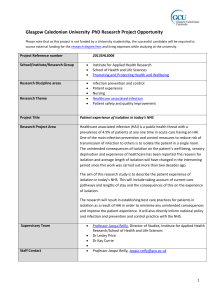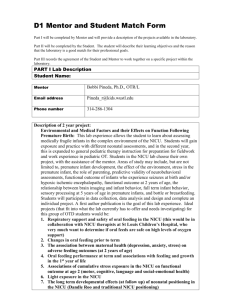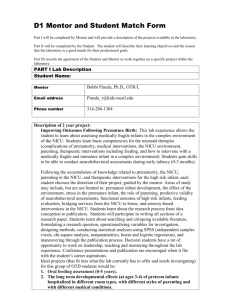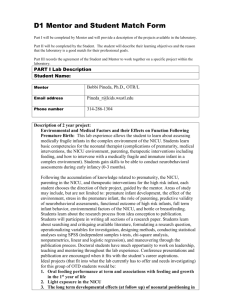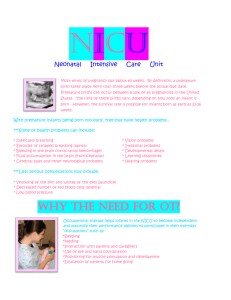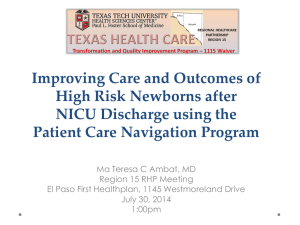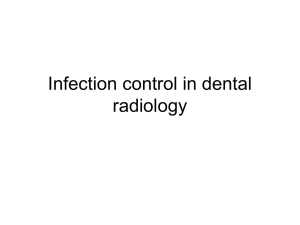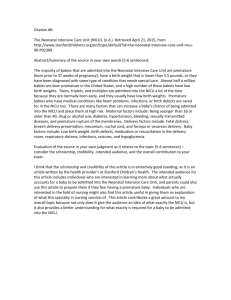infection control policy for nursery
advertisement
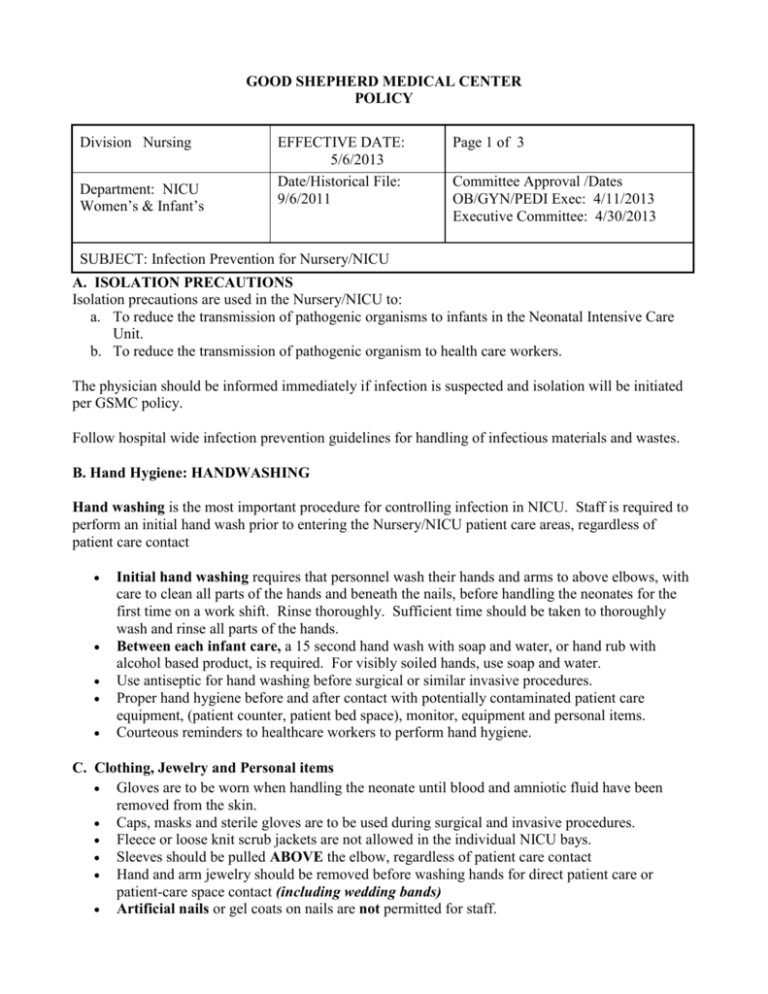
GOOD SHEPHERD MEDICAL CENTER POLICY Division Nursing Department: NICU Women’s & Infant’s EFFECTIVE DATE: 5/6/2013 Date/Historical File: 9/6/2011 Page 1 of 3 Committee Approval /Dates OB/GYN/PEDI Exec: 4/11/2013 Executive Committee: 4/30/2013 SUBJECT: Infection Prevention for Nursery/NICU A. ISOLATION PRECAUTIONS Isolation precautions are used in the Nursery/NICU to: a. To reduce the transmission of pathogenic organisms to infants in the Neonatal Intensive Care Unit. b. To reduce the transmission of pathogenic organism to health care workers. The physician should be informed immediately if infection is suspected and isolation will be initiated per GSMC policy. Follow hospital wide infection prevention guidelines for handling of infectious materials and wastes. B. Hand Hygiene: HANDWASHING Hand washing is the most important procedure for controlling infection in NICU. Staff is required to perform an initial hand wash prior to entering the Nursery/NICU patient care areas, regardless of patient care contact Initial hand washing requires that personnel wash their hands and arms to above elbows, with care to clean all parts of the hands and beneath the nails, before handling the neonates for the first time on a work shift. Rinse thoroughly. Sufficient time should be taken to thoroughly wash and rinse all parts of the hands. Between each infant care, a 15 second hand wash with soap and water, or hand rub with alcohol based product, is required. For visibly soiled hands, use soap and water. Use antiseptic for hand washing before surgical or similar invasive procedures. Proper hand hygiene before and after contact with potentially contaminated patient care equipment, (patient counter, patient bed space), monitor, equipment and personal items. Courteous reminders to healthcare workers to perform hand hygiene. C. Clothing, Jewelry and Personal items Gloves are to be worn when handling the neonate until blood and amniotic fluid have been removed from the skin. Caps, masks and sterile gloves are to be used during surgical and invasive procedures. Fleece or loose knit scrub jackets are not allowed in the individual NICU bays. Sleeves should be pulled ABOVE the elbow, regardless of patient care contact Hand and arm jewelry should be removed before washing hands for direct patient care or patient-care space contact (including wedding bands) Artificial nails or gel coats on nails are not permitted for staff. Charts are not allowed on the isolettes, radiant warmers, cribs, trash cans, and laundry bins. Charts placed on top of the patient-care space should be wiped clean with disinfectant wipes. D. Infection Prevention Principles and Practices to Prevent healthcare associated infections (HAI) in the NICU/Nursery Patient Placement: Provide 4-6 feet intervals between infants. Overcrowding in the NICU increases risk for cross contamination. Skin and Cord Care: Avoid use of alcohol on infant’s skin. Cleanse umbilical cord at first bath. Maintain dry cord care and instruct mother on dry cord care. Gloves should be used when anticipating direct contact with mucous membranes, blood or body fluids, or non-intact skin; having direct contact with infants who are infected or colonized with pathogens transmitted by contact route; or touching visibly soiled or potentially contaminated surfaces or equipment – perform hand hygiene upon removal of gloves. Faucet aerators should not be used. Healthcare workers should be immune to rubella, measles, Tdap and chicken Pox and yearly influenza vaccination is recommended. Individuals with a respiratory, cutaneous, mucocutaneous or gastrointestinal infection, active herpes simplex; should not have direct contact with neonates. Adhere to hospital wide visitation policy for visitation in the Nursery/NICU. E. Medical Devices: Intravenous infusion devices predispose infants to phlebitis and bacteremia. Intravenous catheter placement - Meticulous attention should be given to aseptic insertion and maintenance of the cannula and to aseptic techniques of fluid administration. Preventive measures for arterial lines include aseptically inserting the catheter using gloves, inspecting the site and performing site care every 24 hour, treating the catheter and stopcocks as sterile fields, and minimizing manipulation by drawing all blood specimens at the same time. Bio Patch can be used for infants over 1000 grams. Accessing lines & Tubing changes – all connections are scrubbed for 30 seconds with alcohol and allowed to dry prior to accessing the port or line. Maintain a sterile field, use sterile gloves for TPN/Lipids and central lines. Preventative measures for respiratory therapy devices include using aseptic technique during suctioning; dating open solution for irrigation, humidification and nebulization, and discarding after 24 hours; ensuring routine replacement and cleaning of all respiratory equipment, including ambulation bags, cascade nebulizers, endotracheal tube adaptors, and tubing. Each infant should be issued an individual Stethoscope. It should be wiped clean with disinfectant wipes before and after use and should be placed on the IV poles All equipment that comes in contact with the infant or infant space will be taken apart and cleaned according to manufacturer’s instruction. E. General Housekeeping Dust should not be dispersed into the air during cleaning. Touch surfaces should be disinfected daily. Cabinet counters, work surfaces, and similar horizontal areas should be cleaned each shift and between patient use with a disinfectant wipe or clean cloths. Friction cleaning is important to ensure physical removal of dirt and contaminating microorganism. Sinks should be scrubbed clean and disinfected daily. EVS will maintain separate equipment /supplies for cleaning the NICU. Infants who remain in the nursery for an extended period should be periodically transferred to a different, disinfected unit so that the originally occupied unit can be cleaned. Those infants who have had humidity discontinued should also be transferred to a new unit, if one is available, so that the original unit can be cleaned. G. Contact Precautions for Infected and Colonized Patients A separate room is recommended for isolation. Staffing should be one to one whenever possible. Isolation containers are available from Central Supply and include gloves, gowns, masks, linen bags, trash bags, thermometer, and isolation signs. Consult with Infection Prevention Department and refer to Guidelines for Perinatal Care for types of infection and recommended isolation. Strict adherence to contact isolation is mandatory, regardless of patient contact. Courteous reminder to healthcare workers to observe contact isolation. Emergent entry into the isolation area is at times unavoidable, staff that “break” contact precautions are required to wash their hands thoroughly and change into hospital scrubs Answering of Phones or Pagers is not allowed in the isolation area Charts are not allowed on the isolation carts or laundry bins; avoid placing in patient contact areas. Cohorting to begin at the recommendation of Infection Prevention. Reference: Guidelines for Perinatal Care, (7th Ed.), 2007 2012, American Academy of Pediatrics & American College of Obstetricians and Gynecologists. Merenstein & Gardner, Handbook of Neonatal Intensive Care (7th Ed.), 2011, Mosby, St Louis Moore, Morrell, Biel, APIC Text Online, Chapter 38 & 39. Guzman-Cottrill, Infection Control Practices in the NICU: What is Evidence-based?” NeoReviews 2010: e419-e425 Revised: Stephanie Capt, RN 2/2013

